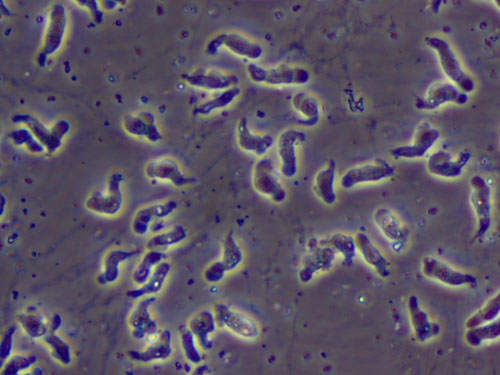Iowa has potential first infection by brain-eating amoeba

These Naegleria fowleri amoebas — at 600x magnification — were collected from the cerebrospinal fluid of someone infected by them. (Photo courtesy of U.S. Centers for Disease Control and Prevention)
A Missouri resident who recently swam at Lake of Three Fires in southwest Iowa is infected by a brain-eating amoeba that is highly lethal, according to public health officials.
The lake near Bedford — about 10 miles north of the Missouri border — is closed for swimming pending tests of the water for Naegleria fowleri, an amoeba that normally feeds on bacteria in lake sediment.
“It’s strongly believed by public health experts that the lake is a likely source, but we are not limiting the investigation to that source, and it’s not confirmed,” Lisa Cox, a spokesperson for the Missouri Department of Health and Senior Services said Friday. “Additional public water sources in Missouri are being tested as well.”
The infection was verified by tests on Wednesday, she said. Iowa health officials announced the beach closure late Thursday.
The U.S. Centers for Disease Control and Prevention is testing the lake water for the presence of the amoeba, which might take several days, said Sarah Ekstrand, a state public health spokesperson. If confirmed, it would be a first for Iowa.
The state does not plan to test other lakes, Ekstrand said.
There have been 154 documented infections in the past six decades in the United States, mostly in the southern part of the country. Texas and Florida account for nearly half of those cases. Research published by the National Library of Medicine estimated the amoeba kills 16 people each year, many of them undiagnosed.
The amoeba is thought to be almost universally deadly — only four of those infected people survived, according to the CDC. It thrives in warm freshwater that has a temperature between about 80 and 115 degrees.
“Naegleria fowleri itself is very common — it’s in the environment and we can’t get rid of it,” Cox said. “However, this brain infection that it can cause is extremely rare.”
Infections can happen when that water goes deep into someone’s nose. The amoeba travels to the brain via the nerves that transmit the sense of smell and destroys brain tissue. Death from infections is usually a result of an immune response that causes the brain to swell.
The amoeba was first identified in Australia in 1965, but a subsequent examination of autopsy tissue samples found that it had killed someone in Virginia in 1937, according to the CDC.
Most infections result from contact with lake or river water, but in 2020 the amoeba was found in the treated water of Lake Jackson, Texas, and killed a 6-year-old boy.
Children are most often the victims. The amoeba killed a 7-year-old girl and a 9-year-old boy in Minnesota in 2010 and 2012, respectively. Missouri documented a case in 1987, but none of Iowa’s other neighboring states have had one confirmed, according to the CDC.
The Missouri resident who was recently infected is under intensive care at an unspecified hospital, Cox said. She declined to reveal the person’s age and gender “out of respect for the family’s privacy.”
People cannot be infected by drinking water that contains the amoeba, and it is not transmissible by infected people.
“These situations are extremely rare in the United States and in Missouri specifically, but it’s important for people to know that the infection is a possibility so they can seek medical care in a timely manner if related symptoms present,” George Turabelidze, the state epidemiologist for Missouri, said in a press release.
Symptoms typically start about five days after infection, according to the CDC, and death usually occurs about five days after that. The first symptoms can include headache, fever and nausea. As the disease progresses, it can cause a stiff neck, seizures and hallucinations. It is called primary amebic meningoencephalitis and is sometimes initially mistaken for bacterial meningitis.
A 12-year-old Arkansas girl and a 16-year-old Florida boy survived their infections in 2013 and 2016, respectively, thanks to quick diagnoses and treatment. That included an amoeba-killing medication, lowering their body temperatures and relieving excessive pressure on their brains, the CDC said.
Health officials said people can limit their chance of infection by keeping their heads out of the water, pinching their nose shut before being submerged or avoiding freshwater altogether when its temperature is high. They also said swimmers should avoid stirring lake sediment.
Category:
The Eagle Grove Eagle
The Eagle Grove Eagle
P.O. Box 6
304 West Broadway
Eagle Grove, IA 50533
Phone: 1-515-448-4745
FAX: 1-515-448-3182
Email: news@eaglegroveeagle.com
Mid-America Publishing
This newspaper is part of the Mid-America Publishing Family. Please visit www.midampublishing.com for more information.